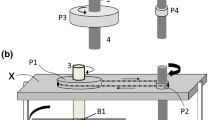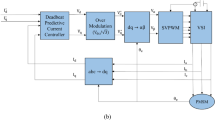Abstract
The rotation vector of the matrix converter has the characteristic that the common mode voltage is zero, so the direct torque control (DTC) strategy using the rotation vector can effectively suppress the common mode voltage of the motor system. However, because the direction of the rotation vector is constantly changing and the distribution is extremely uneven, the existing DTC based on the rotation vector not only has a complicated switching table, but also increases the torque ripple and current harmonics. In this paper, a novel direct torque control strategy using virtual rotation vectors is proposed. The virtual rotation vector is synthesized by the rotation vector with identical rotating direction, and the duty cycle of the selected rotation vector is theoretically derived and calculated, leading to six evenly distributed virtual rotation vectors with fixed relative positions, and therefore a simple-form switching table can be easily constructed. The proposed control strategy is experimentally verified, and the results show that, compared with the traditional rotation vector-based DTC, the proposed strategy not only achieves zero common-mode voltage, but also significantly reduces torque ripple and current harmonics, improving the steady-state performance of the motor system.










Similar content being viewed by others
References
Dan H, Zeng P, Xiong W, Wen M, Su M, Rivera M (2021) Model predictive control-based direct torque control for matrix converter-fed induction motor with reduced torque ripple. CES Trans Electr Mach Syst 5(2):90–99
Wang H et al (2021) A cascade PI-SMC method for matrix converter-fed bdfim drives. IEEE Trans Transp Electrif 7(4):2541–2550
S. B. Mohite and P. K. Gujarathi (2010) A design and implementation of a novel multimode single phase matrix converter. SPEEDAM 2010, Pisa, Italy.
Mei Y, Qiaochu Lu, Huang W (2021) Soft-switching composite modulation strategy for bidirectional isolated AC–DC matrix converters. Proc CSEE 41(7):2474–2484
Yan Y, Wang C, Shi T (2019) Predictive current control strategy of matrix converter with variable switching point. Proc CSEE 39(20):6017–6024
Nasr A, Gu C, Wang X et al (2022) Torque-performance improvement for direct torque-controlled pmsm drives based on duty-ratio regulation. IEEE Trans Power Electron 37(1):749–760
Alsofyani IM, Lee K-B (2020) Enhanced performance of constant frequency torque controller-based direct torque control of induction machines with increased torque-loop bandwidth. IEEE Trans Ind Electron 67(12):10168–10179
Yang J, Huang J (2006) Research on fuzzy direct torque controlling system of induction machine with fuzzy speed regulator. In: 2006 6th world congress on intelligent control and automation, Dalian, China
Liu G-H, Cao Y-L, Zhou H-W et al (2021) Novel switching-table based fault tolerant DTC for five-phase PMSM. Proc CSEE 41(18):6399–6407
Duan Q-T, Zhou Y-Z, Ai-wen Qu (2019) Open-circuit fault-tolerant direct torque control with low torque ripple for six-phase and three-phase PMSM series-connected system. Proc CSEE 39(2):347–358
Boulghasoul Z, Elbacha A, Elwarraki E, et al (2011) Combined vector control and direct torque control an experimental review and evaluation. In: 2011 international conference on multimedia computing and systems, Ouarzazate, Morocco
Hongge Z, Jingwei Z, Yinhai F (2010) Study of direct torque control strategy based on regional interpolation of zero voltage vector in a permanent magnet synchronous motor. In: 2010 international conference on electrical and control engineering, Wuhan, China
Yue F, Wheeler PW, Clare JC (2005) Cancellation of 3rd common-mode voltage generated by matrix converter. In: 31st annual conference of IEEE industrial electronics society, Raleigh, NC, USA
Nath S, Mohan N (2011) A matrix converter fed sinusoidal input output three winding high frequency transformer with zero common mode voltage. In: 2011 international conference on power engineering, energy and electrical drives, Malaga, Spain.
Rui C, Su M, Sun Y, et al (2009) A novel commutation strategy to suppress the common mode voltage for the matrix converter. In: Asia-Pacific power and energy engineering conference, Wuhan, China.
Wang L et al (2018) A finite control set model predictive control method for matrix converter with zero common-mode voltage. IEEE J Emerg Select Top Power Electr 6(1):327–338
Deng W-T, Zhong Qi, Liu Yu, Chen J-J (2021) Reduction of common-mode voltage in matrix convert-fed permanent magnet synchronous motor system with rotating vectors. Electric Machines and Control 25(11):122–129
Deng W, Fu X, Xie W (2020) Reduction of common-mode voltage in matrix convert-fed permanent magnet synchronous motor system with rotating vectors. IEEE Access 8:205894–205901
Wei-tao Deng H, Li JR (2021) A novel direct torque control of matrix converter-fed PMSM drives using dynamic sector boundary for common-mode voltage minimization. IEEE Trans Ind Electron 68(1):70–80
Yan Y, Zhao J, Xia C, Shi T (2015) Direct torque control of matrix converter-fed permanent magnet synchronous motor drives based on master and slave vectors. IET Power Electron 8(2):288–296
Funding
National Natural Science Foundation of China, 52207052, Weitao Deng; Natural Science Foundation of Tianjin City, 20JCQNJC00370, Xiuyun Zhang; Research Project of Hunan Provincial Department of Education, 20C0913, Wangbin Cheng; Science and Technology Program of Hunan Province, 2019TP1014.
Author information
Authors and Affiliations
Corresponding author
Additional information
Publisher's Note
Springer Nature remains neutral with regard to jurisdictional claims in published maps and institutional affiliations.
Rights and permissions
Springer Nature or its licensor holds exclusive rights to this article under a publishing agreement with the author(s) or other rightsholder(s); author self-archiving of the accepted manuscript version of this article is solely governed by the terms of such publishing agreement and applicable law.
About this article
Cite this article
Deng, W., Fu, X., Tang, J. et al. Common-Mode Voltage Minimization of Matrix Converter-Fed Permanent Magnet Synchronous Motor System with Evenly Distributed Virtual Rotation Vectors. J. Electr. Eng. Technol. 18, 1985–1994 (2023). https://doi.org/10.1007/s42835-022-01257-2
Received:
Revised:
Accepted:
Published:
Issue Date:
DOI: https://doi.org/10.1007/s42835-022-01257-2




